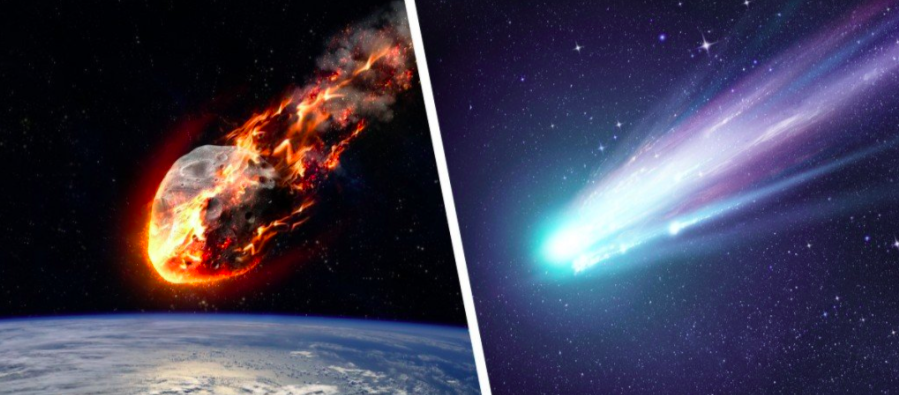Wisley’s Astronomy Briefing Chapter 3 - A Solar System Tour Guide: The Other Items
- Nishant KIDANGAN
- Mar 31, 2022
- 4 min read
Updated: Apr 1, 2022
Wisley’s Astronomy Briefing
Chapter 3
A Solar System Tour Guide: The Other Items
Edited by Yinwa Yung

Image from (Solar System, n.d.)
In this chapter, we will be reviewing the other parts of the solar system that make it so unique. From the sun, moons, dwarf planets to asteroids, comets, meteors, meteoroids, and meteorites
The Sun:

Image from (The Sun, n.d.)
Let’s meet our sun, the largest object at the center of the solar system. The sun is a medium-sized yellow dwarf that is powered by nuclear fusion, made out of 75% Hydrogen and 24% Helium. Even though it takes eight minutes and twenty seconds for sunlight to reach our eyes, it takes one million years for light to move from the sun’s core all the way to touching Earth (Nasa, n.d.). On the chromosphere and the corona, you can clearly see ever-changing activity like sunspots, which are dark areas that become apparent at the Sun's photosphere as a result of intense magnetic flux pushing up from further within the solar interior (NWS, n.d.). Solar flares, a frequent phenomenon, are energetic bursts that eject light and particles due to solar magnetism, not to be confused with prominences, snakelike structures made of cooler, denser solar material that is suspended above the Sun’s surface by a strong local magnetic field (In Depth | Sun –, n.d.). For the most extreme solar outbursts, look no further than coronal mass ejections, or CMEs, immense clouds of charged particles blasted into space by the sun at over one million miles per hour. When impacted Earth, many modern technologies like GPS or cell phone connections will cease to exist as the particles disrupt satellite operations in space.
Moons:
Image from (Staticflickr, n.d.)
When anyone starts mentioning the moons of the solar system, it is natural to start with our own. The Moon is by far the only world outside of Earth that humans have personally explored, and the largest object we can see from the night sky. Its existence balances the Earth’s climate, while the gravitational impact gives us tides in the sea (In Depth | Earth’s Moon –, n.d.). Experts hypothesize that in the long past a giant object the size of Mars collided with the premature Earth, causing its tilt while the by-products formed into the Moon. With help from the sun, the Moon is capable of creating lunar eclipses, solar eclipses, and changing phases depending on its position with the Sun and Earth. While in the other parts of the solar system, planets have collections of their own moons. Mars has Phobos and Deimos, two rocky moons hypothesized to have been captured while flying too close into Mars’ orbit. Jupiter’s most famous satellites named the Galilean Moons, after their discoverer Galileo Galilei, include the volcanically active Io, icy and mysterious Europa, magnetic and large Ganymede, and cratered Callisto. In Saturn’s variety of moons, Titan and Enceladus take the spotlight as they are potential candidates for life to thrive on. While Uranus and Neptune’s moons like Miranda and Triton are freezing cold as they lie on the outer skirts of the solar system.
Dwarf Planets:
Image from (Starwalk, n.d.)
When Pluto was discovered, it was named the ninth planet of the solar system. However, in 2006, it was demoted as the IAC (International Astronomical Union) ruled the planet not able to meet its criteria of clearing out other objects in the pathway (Why Is Pluto No Longer a Planet?, n.d.). Soon, Pluto was demoted into a dwarf planet. An upgrade for Ceres, a dwarf planet that before its promotion was considered an asteroid with other objects found in the asteroid belt. Haumea, Eris, and Makemake are the other companions on the list and they require further exploration to get more information on them. For Ceres and Pluto, spacecraft by the names of Dawn and New Horizons have given us amazing details and images of these small worlds, the latter space probe then flew past a Kuiper Belt object by the name of Arrokoth.
Asteroids, Comets, and Meteors:
Image from (Scienceabc, n.d.)
Aside from all the larger objects in the solar system, there are a lot of little rocks surrounding the solar system. First, asteroids, the pieces of rock left from the beginning of the solar system. Most of them surround the asteroid belt between Mars and Jupiter, while trojan asteroids revolve around the sun in the same orbit as Jupiter. The real threat is near-Earth objects (NEOs), their orbit has an opportunity to intersect with Earth’s orbit, and if a NEO meets up with Earth at the wrong place at the wrong time, disaster will strike. On the other side, there are comets that originate from the Oort Cloud, the farthest reaches of the solar system. When they come closer to the sun, the heat starts to vaporize the dirty snowball and form a tail. When objects like comets emit rocks that approach the Earth, the atmosphere heats them up and forms meteors, when these meteors land on Earth without getting destroyed, they become meteorites that many people collect or store in museums.
Bibliography:
Web Links:
In Depth | Earth’s Moon –. (n.d.). NASA Solar System Exploration. https://solarsystem.nasa.gov/moons/earths-moon/in-depth/
In Depth | Sun –. (n.d.). NASA Solar System Exploration. https://solarsystem.nasa.gov/solar-system/sun/in-depth/
NASA IMAGE satellite,Ask the Space Scientist Archive. (n.d.). Nasa. https://image.gsfc.nasa.gov/poetry/ask/a11354.html
Sunspots/Solar Cycle | NOAA / NWS Space Weather Prediction Center. (n.d.). NWS. https://www.swpc.noaa.gov/phenomena/sunspotssolar-cycle
Why is Pluto no longer a planet? (n.d.). The Library of Congress. https://www.loc.gov/everyday-mysteries/item/why-is-pluto-no-longer-a-planet/










Comments